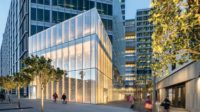A Stitch in the Urban Fabric: Dallas Celebrates Its New Calatrava Bridge








Architects & Firms
Its critics called it a “bridge to nowhere”—borrowing an epithet popularized by Sarah Palin—and it endured 15 years of civic wrangling, but a new span designed by Santiago Calatrava was finally welcomed by the city of Dallas with an opening party that took over its roadway on Friday night. Though the first car will not cross the 1,870-foot automobile-only bridge until the end of March, the celebration kicked off a weekend of events from concerts to a 5K run to inaugurate the new project.
Designed in Calatrava’s signature style, the cable-stayed bridge supports its length with 58 steel cords strung from a 400-foot-high arch, creating a delicate white form that resembles a string instrument. Named after a late local philanthropist whose family donated $12 million toward the $182 million structure, the Margaret Hunt Hill Bridge crosses the Trinity River and connects Downtown to the city’s West Dallas section.
“This is now the center of Dallas,” said the Spanish architect and engineer, standing on the bridge during one of the weekend’s events. His comment reflected the project’s place in a wider ambition shared by many in the city, which is known for its sprawling suburban mextroplex. With public projects that connect far-flung areas and help tame a tangle of congested freeways, both the city and a prominent group of private donors hope to direct more development to downtown Dallas, where residential, cultural, and commercial project have already taken root.
The crossing is part of the Trinity River Corridor Project, a $1 billion-plus plan to overhaul a 20-mile stretch of the river with new infrastructure, better flood protection, recreation areas, and a toll road to pay for its upkeep. The project has elicited controversy over everything from its cost to the environmental affect of the road. Margaret Hunt Hill was to be one of three bridges designed by Calatrava included in the scheme, but as of publication, cost cuts have left the architect working on only the pedestrian areas and approaches of one additional bridge.
Critics balked at the cost of the now-completed Calatrava project, but though they have suggested otherwise, the bridge does, in fact, go somewhere. It crosses from downtown to a largely working class and Latino neighborhood in West Dallas that sits just to the north of gentrified Oak Cliff and the Bishop Arts District. Long overlooked because of its grit and poverty, the neighborhood’s new proximity to downtown and the success of neighboring Oak Cliff, have made it ripe for development—a prospect that some fear will drive out longtime residents.
A similar but unrelated project to the east of the bridge is also drawing new connections through the city. Built on a street-grade platform over a sunken highway, the 5.2-acre Klyde Warren Park will join the city’s primary performing arts district, which includes recently completed projects by Foster + Partners and OMA, to adjacent neighborhoods. Designed by landscape architect James Burnett, the park will not only make the area more walkable, it will also include a dog run, open spaces for exercise classes, and a restaurant by Thomas Phifer and Partners, among other amenities. The $110 million project—named for the nine-year-old son of energy billionaire Kelcy Warren, who gave an undisclosed amount to the project—is on track to wrap up construction the fall. It has already spurred residential development along a previously undesirable stretch of freeway.
Back in Wast Dallas, both supporters of transforming the neighborhood and those who oppose its gentrification agree that the bridge will be a catalyst. “It’s going to change everything,” says Greg Brown, program director for the Dallas Center or Architecture. “In fact, it already has.”
On the way to Friday Night’s festivities, among the auto repair shops, bail bond purveyors, and tacquerias along the western approach to the bridge, a recently opened gallery and boutique was having a party of its own. Just down the road, people on their way to the reception drove past murals by Los Angeles artist Shephard Fairy painted on industrial buildings—many already claimed by developers—to the reception. Those who bought $200 tickets watched a succession of speeches and a Lyle Lovett concert at the center of the bridge, while others stood outside the gates on either side. All of them gazed up to Calatrava’s beautifully tuned span, an emblem of change in the neighborhood and in the city.






